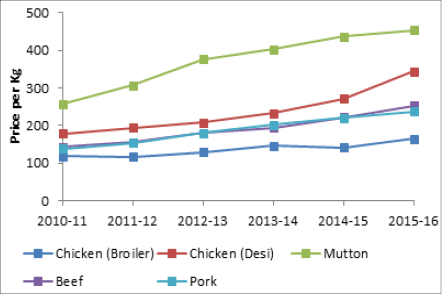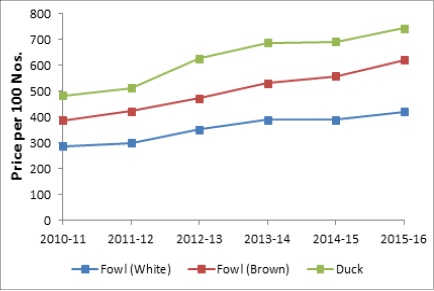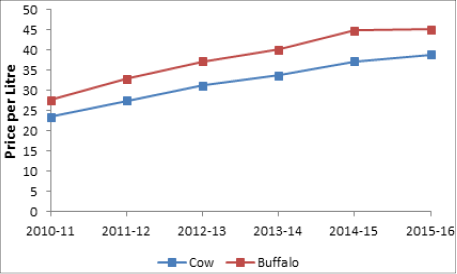Agriculture and Allied Sectors
Livestock Development
Livestock is a major source of livelihood for the World’s poor. It is an integral part of India’s agricultural economy and plays a multifaceted role in providing livelihood support to the rural population. Livestock sector apart from contributing to national economy in general and to agricultural economy in particular, also provides employment opportunities, asset creation, coping mechanism against crop failure and social and financial security. Livestock is the main source of animal protein for the population. Small and marginal farmers and landless labourers own majority of the livestock resources. Also sustainable development of the livestock sector would lead to more inclusive development and empowerment of women. Livestock sector contributed 3.03 percentage of the Gross State Value Added (GSVA) and 29.18 percentage of the GSVA in Agriculture and Allied activities during 2015-16 (at constant price with base year 2011-12).
Production of Major Livestock Products
Milk
India ranks first among the world’s milk producing nations. At the national level, milk production has increased from 1026 lakh MT in 2006-07 to 1279 lakh MT in 2011-12. Milk production during 2014-15 and 2015-16 was 1463.10 lakh MT and 1554.90 lakh MT respectively, registering an annual growth rate of 6.27 per cent. Among the major milk producing states in India highest is in Uttar Pradesh (263.87 lakh MT) followed by Rajasthan (185 lakh MT) Gujarat (122.62 lakh MT) and Madhya Pradesh (121.48 lakh MT). Kerala ranks 14th with a production of 26.50 lakh MT in
2015-16.
Milk production in the State increased from the level of 21.19 lakh MT at the end of the tenth plan (2006-07) to 27.16 lakh MT at the end of the eleventh plan (2011-12). Milk production during 2014-15 and 2015-16 was 27.11 lakh MT and 26.50 lakh MT respectively with an annual growth rate of 2.11 per cent and (-)2.25 per cent respectively. Annual Growth rate of milk production during 2015-16 in the State is far below that at the national level. During 2015-16, Kerala contributed only 1.70 per cent of the annual milk production of the country.
The production of major livestock products at the National level and State level are shown in Table 2.5.
Table 2.5
Production of major livestock production
| SlNo | Year | Kerala | India | ||||
| Milk (lakh MT) (growth per cent) | Egg (crore) (growth per cent) | Meat (lakh MT) (growth per cent) | Milk (lakh MT) (growth per cent) | Egg (crore) (growth per cent) | Meat (lakh MT) (growth per cent) | ||
| 1 | 2006-07 (Xth Plan ) |
21.19 | 119.39 | 1.98 | 1026 | 5066 | 23 |
| 2 | 2011-12 (XI Plan ) |
27.16 (2.76) | 170.48 (1.97) | 4.26 (24.91) | 1279 (5.01) | 6645 (5.44) | 55 (14.58) |
| 3 | 2012-13 | 27.9 (2.72) | 223.7 (33.22) | 4.01 (-5.78) | 1324 (3.52) | 6973 (4.94) | 59 (7.27) |
| 4 | 2013-14 | 26.55 (-4.83) | 247.69 (10.72) | 4.16 (3.76) | 1376.8 (3.99) | 7475.2 (7.2) | 62 (5.08) |
| 5 | 2014-15 | 27.11(2.11) | 250.36 (1.08) | 4.46 (7.16) | 1463.1 (6.27) | 7848.4 (4.99) | 67 (8.01) |
| 6 | 2015-16 | 26.50 (-2.25) | 244.25 (-2.44) | 4.66 (4.48) | 1554.90 (6.27) | 8292.94 (5.66) | 70.20 (4.78) |
Source: Animal Husbandry Department
The production of milk and annual percentage change from 2008-09 to 2015-16 of the State is shown in Figure 2.5.
Figure 2.5
Milk production and growth rates in Kerala

Source: Animal Husbandry Department
Egg/Meat
At the national level, egg production at the end of the 11th plan (2011-12) was 6645 crore as compared to 5066 crore at the end of the 10th plan (2006-07). Egg production during 2014-15 and 2015-16 was 7848.4 crore and 8292.94 crore respectively with an annual growth rate of 4.99 per cent and 5.66 per cent respectively. Tamil Nadu is the largest egg producing state in India (1612.52 crore) followed by Andhra Pradesh (1417.43 crore), Telangana (1120.58 crore) and West Bengal (601.08 crore). Kerala ranks 9th with egg production of 244.25 crore in 2015-16. At the national level, meat production increased from the level of 23 lakh MT (2006-07) to 55 lakh MT during 2011-12. Meat production during 2014-15 and 2015-16 was 67 lakh MT and 70.2 lakh MT respectively. The annual growth rate during the above period was 8.01 per cent and 4.78 per cent respectively. Among the Indian states Uttar Pradesh is the largest meat producer (14.18 lakh MT) followed by West Bengal (6.86 lakh MT), Maharashtra (6.75 lakh MT), and Andhra Pradesh (5.66 lakh MT). Kerala ranks 7th with production at 4.66 lakh MT in 2015-16.
Egg production in the State increased from 119.39 crores at the end of the Tenth Plan (2006-07) to 170.48 crores during the year 2011-12. The egg production during 2014-15 and 2015-16 was 250.36 crores and 244.25 crores respectively with an annual growth rate of 1.08 per cent and (-)2.44 per cent respectively. Meat production in the State increased from the level of 1.98 lakh MT at the end of the tenth plan (2006-07) to 4.26 lakh MT during the year 2011-12. The meat production during 2014-15 and 2015-16 was 4.46 lakh MT and 4.66 lakh MT respectively with an annual growth rate of 7.16 per cent and 4.48 per cent respectively. Growth of egg production in the state during 2015-16 is far below the national level while for meat the growth percentage during 2015-16 is almost the same as that at the national level. During 2015-16 Kerala contributed 2.95 per cent of the annual egg production and 6.64 per cent of the annual meat production of the country.
The production of Egg/Meat and corresponding growth rates from 2008-09 to 2015-16 of the State is shown in Figure 2.6 and 2.7. During the period 2008-09 to 2015-16, annual growth rate was maximum for egg during 2012-13 and for meat during 2009-10.
Fig 2.6
Egg production and growth rate

Source: Animal Husbandry Department
Figure 2.7
Meat production and growth rate

Source: Animal Husbandry Department
Milk Marketing
During 2015-16, a total of 5929 lakh litres of milk was procured by the dairy co-operative societies in the State of which 3795 lakh litres were sent to the dairies and 2134 lakh litres were marketed locally by the societies. The average milk procured per day by Anand Pattern C-opertaive Societies (APCOS) during the year 2015-16 was 1109 MT against the previous year average of 1026 MT. The procurement/day/society during 2015-16 increased to 380 litres from 348 litres in 2014-15. The procurement of milk by Kerala Co-operative Milk Marketing Federation (KCMMF) increased to 4334.81 lakh litres against the sale of 4624.51 lakh litres during 2015-16. Except in Palakkad, Wayanad and Kattappana Dairy, the sales of milk exceeded the procurement. The shortfall between milk procurement and sales was met by arranging milk mostly from state milk federations of Karnataka, Tamil Nadu, and purchase of skimmed milk powder. Data on procurement and sale of milk by different dairies of KCMMF during 2011 to 2016 is given in Appendix 2.22 and performance of KCMMF during 2011-12 to 2015-16 are shown in Appendix 2.23 and average quantity of milk procured per day by APCOS are shown in Appendix 2.24. The price revision and price spread of milk from 2009 onwards is given in Appendix 2.25 and Appendix 2.26 respectively
Weak Feed and Fodder Base
Special focus has been given to fodder and feed production in Kerala to support the development of the livestock sector considering the wide gap in the availability of these two critical inputs. The Dairy Development Department is the nodal agency for fodder development activities in the State. During the year 2015-16, the Department could add 2686 ha to the existing cultivated area resulting in 4.62 lakh MT more of green fodder to the existing stock. Assistance was provided to farmers for Azolla cultivation, mechanization of fodder cultivation and harvesting, and irrigation facilities. Fodder exhibitions and workshop were also included in the fodder development activities. Innovative fodder development programs under Integrated Dairy Development Program were implemented in the districts of Kannur, Idukki and Ernakulam. To overcome shortage of raw materials for cattle feed production, maize was cultivated in 100 Ha of land producing 350 tons of maize grain. The total production of cattle feed during 2015-16 was 3.97 lakh metric tonne as against 3.61 lakh MT during 2014-15. Dry fodder marketing activities were taken up by 70 Dairy co-operative societies and Fodder cultivation and fodder marketing activities were taken up by 50 women groups. The production of feed and fodder are shown in Appendix 2.27, Appendix 2.28 and Appendix 2.29.
Breeding Support
Kerala Livestock Development Board (KLDB) is involved in the production and distribution of frozen semen. Compared to 2014-15, semen production decreased from 34.45 lakh doses to 24.47 lakh doses during 2015-16. The distribution inside the State increased from 17.55 lakh doses to 17.65 lakh doses and outside the state decreased from 11.26 lakh doses to 10.71 lakh doses respectively during this period. Details are shown in Appendix 2.30.
The number of Artificial Insemination (AI) centres in the State during 2015-16 was 2515. The number of inseminations done during 2015-16 was 13.00 lakh and calving recorded was 3.25 lakh. The average number of inseminations needed for producing one calf is 4. The details of AI are shown in Appendix 2.31. The quality of AI has not shown any improvement and so measures to improve the quality of semen supplied needs to be taken up immediately. The activities of the KLD Board are given in Appendix Appendix 2.32.
Special Livestock Breeding Programme (SLBP)
Calf rearing in Kerala is an expensive activity. Farmers compromise with the management practices and nutrition to save expenses. Consequently, the growth and reproductive performance of the animals are affected adversely. Providing assistance for balanced feeding and scientific management can solve the issue to a major extent. The SLBP was initiated in Kerala in 1976 with the above objective. During 2006-07 the scheme was extended to buffalo calves also as a measure to curtail the drastic reduction in the buffalo population. Enrolment of buffalo calves shows a decreasing trend and no buffalo calves were enrolled during the period 2014-15 and 2015-16. During 2015-16, 29164 calves were only enrolled under this programme against 84,712 calves during 2014-15. Year wise details from 2005-06 onwards are shown in Appendix 2.33.
Govardhini
Govardhini is a new scheme started in the state from 2014-15 onwards with the objectives of providing total health care to the calves like reducing the age at puberty, age at first calving and inter caving period of the female calves borne in Kerala for increasing milk production in the state. Scientific Management, feeding with adequate quantity of good quality feed and health cover including prevention against common contagious diseases and insurance cover against loss due to unforeseen reasons are the basic requirement in achieving the goal. All these aspects are comprehensively covered in this scheme. Beneficiaries are selected from the calf birth register maintained at Government veterinary dispensaries on first come first serve basis. During 2014-15 and 2015-16, 48000 calves were enrolled under this program.
Animal Health Care
Though there is an improvement in the quality of livestock through cross breeding programs, the susceptibility of animals to various diseases including exotic diseases has increased. The animal husbandry department provides veterinary care mainly through 14 district veterinary centres, 50 veterinary polyclinics, 215 veterinary hospitals, 885 veterinary dispensaries, 9 mobile veterinary hospitals, 7 mobile farm aid units and 1 motorboat veterinary hospital.
The Department through the Animal Disease Control Project has successfully taken up massive foot and mouth vaccination campaign in order to prevent foot and mouth disease (FMD) outbreak and also vaccinations for poultry and ducks against avian diseases. During 2014-15, the highly pathogenic Avian Influenza (Bird flu) outbreak occurred in the State, especially in Alappuzha, Kottayam, Pathanamthitta and Kollam districts. The disease was due to highly pathogenic H5N1 strain which is of zoonotic importance. Effective and timely action was taken by the Animal Husbandry Department by coordinating containment operations in liaison with respective district administrations and local self-governments. Compensation was provided to the farmers. During 2016-17 also Avian Influenza outbreak occurred with H5N8 strain in Alappuzha and Kottayam districts. More than 7 lakh ducks were culled as part of containment operation. Data regarding outbreaks, attacks and deaths of major contagious diseases of animals in Kerala for the period from 2009-10 to 2015-16 are given in Appendix 2.34. Anthrax, Hemorrhagic Septicemia, FMD and Black Quarter have been reported during 2015-16. Number of attack of Hemorrhagic Septicemia and FMD were very high during 2015-16 compared to 2014-15.
Emergency Veterinary Service during night hours
The service of a Veterinary Doctor is available only in the day time and it is difficult to get the service during odd hours of the day. Hence a project was formulated during the 12th plan to provide the expert veterinary care at block level from 6 pm to 6 am. The service of a registered veterinary practitioner is provided on contract basis. The unit is functioning under the direct supervision of one identified veterinary institution of the block area. Medicines are made available to them. The veterinarian on contract basis has to submit monthly reports to the veterinary officer of the concerned block in which the unit is attached. Emergency night veterinary service was established in 50 selected blocks of the state upto 2015-16 and during 2016-17 this was extended to 65 blocks.
Production of Vaccine in Institute of Animal Health and Veterinary Biologicals, Palode
The Institute of Animal Health and Veterinary Biologicals, Palode is the sole agency engaged in the production and distribution of animal vaccine in the State. The production details of vaccines manufactured here are shown in Appendix 2.35. During 2015-16, the production of poultry vaccine was 248.29 lakh doses and livestock vaccine was 4.36 lakh doses. Compared to the previous year, production of poultry vaccine decreased by 9.61 per cent and livestock vaccine increased by 2.14 per cent . Number of vaccinations done during 2015-16 was 24.90 lakh numbers for livestock and 106.36 lakh numbers. for poultry. Compared to the previous year, vaccination to cattle increased by 15.49 per cent and vaccination to poultry decreased by 31.19 per cent. Anti Rabies Vaccinations done in dogs increased from 1.79 lakh nos. to 2.87 lakh nos. during 2015-16. Details are given in Appendix 2.36.
Prices
Average price of important inputs and products of livestock sector for the last six years is presented in Appendix 2.37 and almost all the products recorded increase in prices during the period. Compared to 2014-15, there was increase in the price of all categories of meat during 2015-16. The price of chicken broiler increased by 16.06 per cent, chicken (Desi) by 27.37 per cent, mutton by 3.92 per cent, beef by 14.25 per cent and pork by 7.48 per cent. During 2015-16, the highest increase was in the case of chicken (Desi) (27.37 per cent), followed by chicken broiler (16.06 per cent). Compared to 2014-15, the price of fowl-white egg increased by 7.69 per cent, brown egg by 10.91 per cent and duck egg by 7.51 per cent during 2015-16. Compared to 2014-15, the price of cow milk increased by 4.54 per cent and buffalo milk by 0.76 per cent during 2015-16.
On the input side, the price of straw increased by 6.72 per cent and grass by 3.14 per cent during 2015-16. Compared to the previous year, the price of groundnut cake increased by 11.48 percent, coconut cake by 7.79 per cent and gingely oil cake by 7.61 per cent during 2015-16. The increase in the price of inputs is a serious threat to dairy farming and hence the possibility of indigenous source of feeds is to be explored. The trend in average prices of livestock products from 2010-11 to 2015-16 are shown in Figure 2.8.
Figure 2.8
Trends in Average Prices of Livestock Products from 2010-11 to 2015-16
Meat

Egg

Milk

Feeds

Source: Animal Husbandry Department
Annual Plan 2014-15
Annual Plan 2015-16 earmarked an outlay of 299.38 crore and 79.00 crore for Animal Husbandry and Dairy Development sub sectors and expended 187.66 crore (62.68 per cent) and 77.76 crore (98.43 per cent) respectively. Special Livestock Breeding Programme (SLBP) and Strengthening of Veterinary Services were two major projects implemented with an outlay of 46.39 crores and 36.37 crore respectively and 46.14 crore (99.46 per cent) and 26.80 crore (73.69 per cent) were spent. Under dairy development, milk shed development and assistance to primary dairy co-operatives are the major schemes implemented with an outlay of 36.25 crore and 16.50 crore respectively and 35.96 crore (99.20 per cent) and 16.47 crore (99.82 per cent) were expended.
Key initiatives in 2015-16
The key initiatives of the Dairy Development and Animal Husbandry Department are shown below:
- Emergency Veterinary service during odd hours extended to 65 selected blocks of the State.
- Strengthening of infrastructure facilities of laboratories for improved disease diagnosis and surveillance
- Antirabies vaccination campaign was implemented to control the dog population and eliminate rabies in Kerala by 2020.
- Comprehensive vaccination campaign against Foot and Mouth disease was implemented
- For Govardhini, an amount of 36.00 crore earmarked.
- Augmenting poultry production through villages.
- Assistance for the infrastructure development of State Dairy Lab, Thiruvananthapuram
- Integrated Dairy Development programme for Kollam and Ernakulam districts with plan outlay of 15 crore.
- Establishment of permanent Milk checking facility at Walayar and Meenakshipuram.

